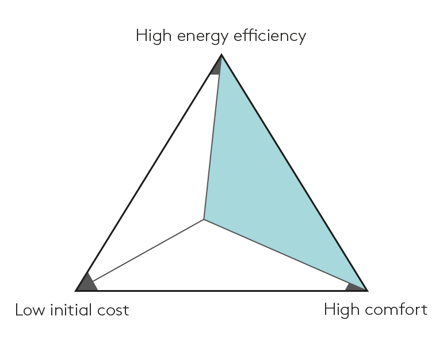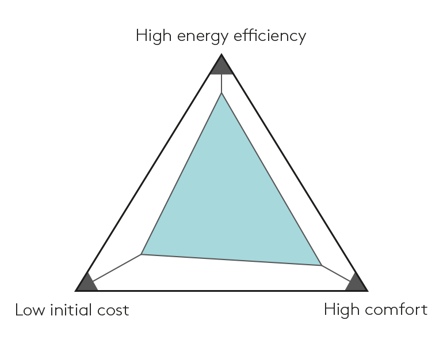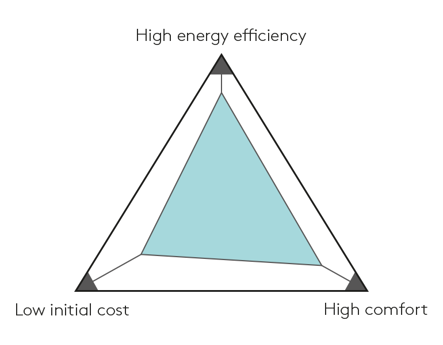
Residential ventilation
Newbuild or upgrade installation? Need flexibility? Demanding energy requirements? Each project is unique and a great many factors determine the ideal ventilation system. However, the choice of residential ventilation system will essentially be based on three factors: comfort requirements, energy requirements and initial cost. This guide gives you the answers to all you need to know about ventilation in apartment buildings.
Energy, comfort and initial cost
Each project, regardless of whether it entails a newbuild or upgrade installation, has a specific requirements picture, and the aim is to find the system solution to match that given project. The object is obviously a system that is ideal in terms of energy efficiency, comfort and running costs, but in practice, some priorities will have to be made. What are the main criteria for your project?
Indoor climate and health
Research reveals a clear link between indoor climate quality and human health. A large number of homes are failing to meet national air change requirements. In eight out of ten apartments in tower blocks, the air change rate is too low, and 40 per cent of all children are affected by asthma or allergies. Good ventilation halves this risk to child health.
Poor indoor climate is typically caused by hazardous substances emitted by construction materials (e.g. radon), and by moulds and air pollutants. High humidity in buildings and in indoor air can also be a factor. This means that the air in residential properties needs to be replaced continually.
More about radon in homesEnergy consumption and the environment
Assessing residential ventilation systems and their control is the first step towards reducing energy bills and running costs. A reduction in the energy requirement for achieving the desired indoor climate also means that your carbon footprint will be reduced. A great place to start is by recovering the heat from the spent ventilation air.
One way of achieving this without compromising on either indoor climate or air quality, is to demand-control the climate in each apartment. The result is a comfortable indoor climate with minimum energy consumption and maximum energy recovery, which also meets all the requirements for supply and extract air flows.
Tip:
Read all about and compare different ventilation solutions further down

Maintenance and Life-Cycle Cost
With full control over the entire ventilation system, ongoing maintenance will also be easier. With integrated functionality for monitoring and logging, the need is reduced for building management systems, which provides simplicity and reliability while lowering the investment cost. With solutions for remote access, you gain complete control over your system, wherever you happen to be. All these facilities save considerable time and energy in the long term, making them a key factor to consider in choosing a system.
Which solution is right for my project?
The best starting point is to address the requirements for the property and their order of priority. Bearing these in mind makes it easier to pick the right type of system from the outset. Below, we review different types of ventilation systems for apartment buildings, covering the advantages and disadvantages, and provide a profile to indicate the best match for the given requirements. Regardless of the priorities, there will be an ideal solution for every project!



